China Focus: Tianwen 1 mission marks first year on Mars


FRUITFUL RESULTS
Since landing, Zhurong has continued moving southward and transmitted data back to Earth. It has completed explorations of the Martian surface, passed through multiple complex terrains, and detected Martian rocks, sand dunes and impact craters, obtaining a large amount of data using its onboard scientific equipment.
By Aug 15, 2021, Zhurong had worked on the planet's surface for 90 Martian days, or about 92 days on Earth, accomplishing all exploration and detection tasks as planned. It was in good condition and continued service despite reaching its planned working target of 90 days.
From mid-September to late October last year, the Mars orbiter and Zhurong suspended their explorations and relied on their own autonomous systems to survive their first solar outage, during which time solar electromagnetic radiation increased and disrupted communication between the probe and Earth.
In November 2021, Zhurong and the European Space Agency's Mars Express spacecraft performed an in-orbit relay communication test.
In May this year, using data gathered by Zhurong on the landing site, Chinese scientists found new evidence suggesting the presence of liquid water activity and hydrated minerals on the red planet.
By May 5, 2022, the Tianwen 1 orbiter had been operating for 651 days at a distance of 240 million kilometers from Earth. Zhurong had been working for 347 Martian days and traveled 1,921 meters. The orbiter and rover, operating normally, had obtained approximately 940 gigabytes of data.























